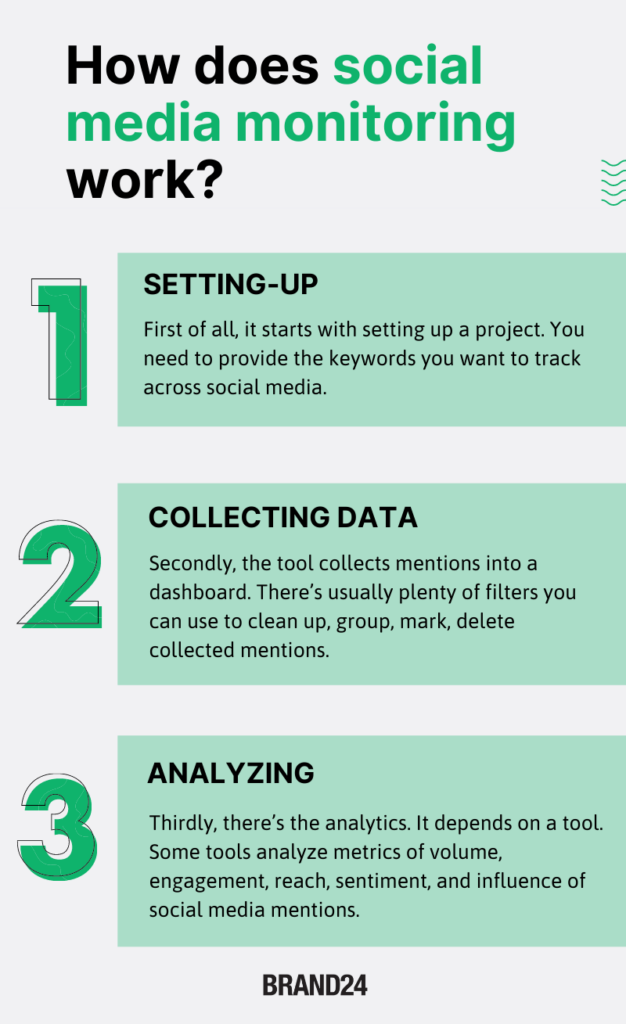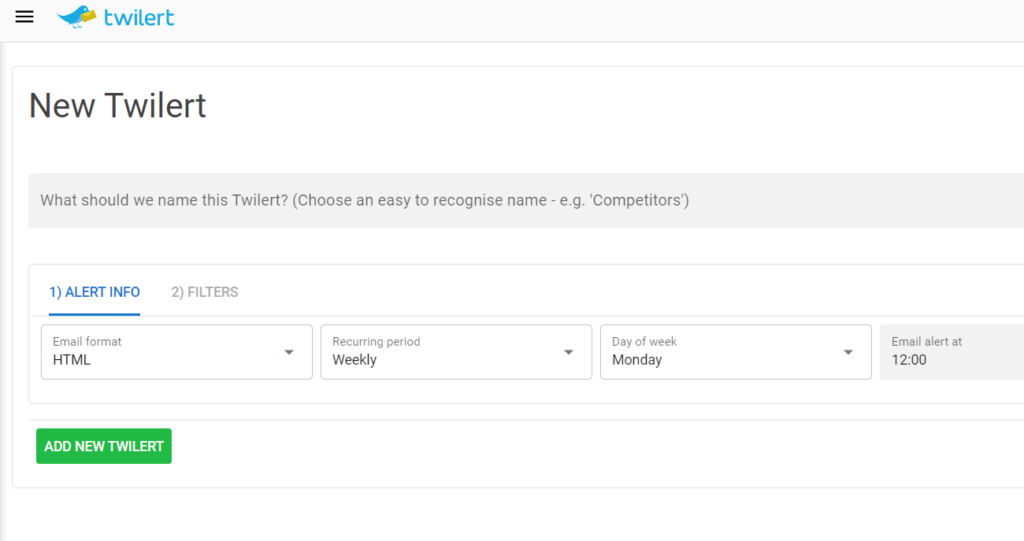Tracking and analyzing conversations about your brand and industry on social media is essential for gaining valuable insights. Investing in a robust social media monitoring solution allows you to gather the information needed to make informed decisions. Without proper monitoring, important data on how your brand is perceived and performs in the marketplace is missed.
Monitoring customer satisfaction is crucial for identifying whether your offerings meet expectations and pinpointing areas for improvement. Additionally, staying updated on conversations about your competitors helps you identify trends, seize opportunities, and remain competitive in your industry.
What is Social Media Monitoring?
Social media monitoring involves tracking and collecting social conversations and messages to understand your customers’ preferences, dislikes, desires, and evolving needs. It also includes actively responding to relevant discussions about your brand. This is a reactive strategy that covers all types of mentions, including reviews, product inquiries, and service complaints.
It’s important to recognize that social media monitoring and social listening are two distinct practices. While they complement each other in an overall strategy, they serve different purposes. Monitoring focuses on what is being said about your brand while listening goes deeper into understanding why these conversations are occurring.
With monitoring, you engage directly with customers, addressing their concerns and participating in discussions specifically related to your brand. In contrast, listening offers a broader perspective, helping you grasp industry trends and your audience’s wider interests. This approach allows you to observe and participate in brand-related conversations, providing immediate insights and opportunities for interaction.
Social media monitoring goes beyond direct mentions or comments on your own posts. It also includes conversations where your brand is mentioned without tagging you, which often don’t appear in your usual notifications. That’s why setting up social media monitoring tools is essential for capturing these indirect mentions and staying aware of what’s being said about your brand across different platforms.
Social Media Monitoring vs Social Listening
Monitoring side with icons like alerts, chat bubbles, and notifications. Listening side with trend charts, magnifying glass, and global map.
While the primary goal of social media monitoring is to efficiently respond to customer interactions, social media listening goes a step further by generating valuable insights that can inform future strategies. Though they work together, these two approaches have distinct differences that can be broken down into three key categories.
Micro vs. Macro
At first glance, social media monitoring and social listening may seem similar, but they operate at different scales. Social media monitoring focuses on a micro level, zeroing in on
- Individual mentions,
- Customer queries,
- Issues,
- Comments about your brand.
It’s designed to track specific interactions. On the other hand, social listening takes a macro perspective, analyzing the broader conversation around your brand, products, and industry as a whole, including competitors. This gives companies a larger view of public sentiment and overall trends.
Reactive vs. Proactive
Social media monitoring is inherently reactive. It’s about responding quickly to what your audience is saying in real time, whether it’s answering questions or addressing complaints.
For instance, if a customer expresses dissatisfaction with a product, monitoring allows you to react promptly and resolve the issue. Conversely, social listening is proactive, focusing on uncovering deeper insights through analyzing patterns in online discussions. It identifies long-term opportunities to better meet consumer needs by recognizing trends and making informed adjustments that address emerging concerns or desires.
Manual vs. Automated
The proportion between human and automated operations is another important distinction. Because it frequently entails reacting to alerts or notifications when your company is referenced, social media monitoring is more automatic. On the other hand, it takes more work to manually find untagged mentions, frequent misspellings, or oblique connections to your brand.
Conversely, social listening involves more manual effort and encompasses more than simply direct mentions of your company. It entails:
- Listening in on industry-wide discussions;
- Analyzing competitors;
- Figuring out general customer mood.
Although some of this process may be automated with the help of technologies, turning raw data into insights that can be put to use frequently requires human interpretation.
While a lot of businesses watch social media extensively, they don’t always go toward social listening. By integrating the two strategies, companies are better able to improve their services and fortify their relationships with customers by not only responding to specific consumer encounters but also implementing significant changes based on thorough insights.
How Social Media Monitoring Works

A wide range of social media monitoring tools is available to track online activity and conversations. These tools provide comprehensive reports on industry-specific keywords being discussed globally. You can also manually add keywords to tailor your monitoring for future marketing strategies.
Choosing the right keywords and phrases is essential to get the most out of social media monitoring. Begin by assessing your brand’s performance to identify strengths and weaknesses. Next, study your competitors to understand how they are addressing customer needs and market demands. This analysis will help you identify key areas of focus. After this, expand your keyword list to include broader industry terms, trending topics, and related phrases to give your social media monitoring tool a more complete view of the conversations happening across platforms. This comprehensive approach ensures you capture valuable insights to guide your strategy.
The tool will gather key data from various websites and send you automatic alerts when your chosen keywords are mentioned. These tools also offer features like analyzing keyword density and utilizing pattern-matching algorithms, helping you avoid potential issues and stay ahead of trends.
To enhance your social media monitoring efforts, consider exploring who follows who on Twitter to understand the connections and influence within your industry, which can help you identify trends and benchmark your performance against competitors.
Why Do Brands Use Social Media Monitoring?
To Answer Customer Questions
For example, imagine a customer tags your airline on social media, asking about the cost of checking an extra bag. Brands that effectively use social media monitoring quickly respond with relevant information. It’s important for representatives to stay engaged, ensuring they address any follow-up questions the customer may have.
To Address Issues or Complaints
While not all inquiries are urgent, handling complaints quickly is essential to prevent negative situations from escalating. For instance, if a customer becomes frustrated because the in-flight WiFi didn’t work, the airline must act fast to resolve the issue and protect its reputation.
Ignoring such problems is like failing to answer a support line, but worse, as it plays out publicly for other users to see. In this case, the airline should apologize for the inconvenience, explain how they’ll prevent the issue in the future, and, if needed, offer compensation such as a voucher or discount.
To Acknowledge Positive Feedback
Not all interactions on social media are negative. It’s important for brands to recognize and respond to positive comments as well. Too often, praise goes unnoticed because there’s no immediate problem to address. However, ignoring positive feedback is akin to hanging up on a happy customer without saying thanks.
Best practices suggest responding to such comments with gratitude and offering further assistance if needed. For example, “We’re thrilled to have helped! Let us know if there’s anything else we can do for you.”

The Key Advantages of Social Media Monitoring
For companies of all sizes, there are several advantages to keeping an eye on your social media presence and following online discussions. Monitoring brand activity across social media platforms can be a useful tool for growth as well as a protective barrier, regardless of the size of your company.
To further enhance your social media monitoring efforts, especially when targeting business audiences, exploring strategies for Twitter B2B marketing can provide valuable insights and opportunities.
Social media monitoring helps you protect your business while also enhancing its exposure and reputation by fusing cutting-edge technology with human understanding. Here is a deeper look at a few of the most significant advantages:
- Engage with Key Market Influencers: Monitoring allows you to identify and connect with the most valuable members of your target audience. By engaging with influencers and loyal customers, you can build stronger relationships and foster brand loyalty;
- Deliver Outstanding Customer Service: Real-time monitoring helps you respond quickly to customer inquiries, complaints, or feedback. This enables you to provide top-tier customer service, ensuring that your clients feel heard and valued;
- Measure and Optimize Marketing ROI: By tracking the performance of your marketing campaigns, social media monitoring helps you measure their effectiveness, allowing you to make data-driven adjustments that maximize your return on investment;
- Gain an Edge Over Competitors: Monitoring not only helps you understand what people are saying about your brand but also what they’re saying about your competitors. This insight enables you to stay ahead of the competition by identifying their weaknesses and capitalizing on opportunities;
- Spot Emerging Trends: Keeping track of conversations around your brand and industry allows you to predict and act on new market trends. By staying informed, you can quickly adapt to shifts in consumer behavior and capitalize on emerging opportunities;
- Safeguard Your Brand’s Reputation: In the event of a PR crisis, social media monitoring helps you act swiftly to mitigate damage. By identifying potential issues early, you can protect your brand’s reputation and respond with effective crisis management strategies.
Proven Methods for Optimizing Social Media Monitoring
Maximizing the effectiveness of social media monitoring begins with careful planning. Start by pinpointing any gaps in your current marketing strategy that monitoring can help improve. If you are also utilizing social listening tools, make sure they are fully integrated into your approach for a more comprehensive analysis. Define clear objectives, monitor the right metrics, and select the most relevant platforms and keywords to achieve optimal outcomes.
By following these steps, you can build a solid foundation for your social media monitoring program and ensure a successful and efficient implementation.
Establishing Clear Goals for Successful Social Media Monitoring
To create an effective social media monitoring strategy, it’s essential to start by setting clear and well-defined objectives. Determine what you want to achieve and identify the key metrics you plan to track.
For example, you might aim to better understand consumer sentiment and take steps to improve it. Having the right tools and resources in place is crucial to reaching these objectives and ensuring success.
Choosing the Right Tools for Social Media Monitoring
With a wide range of social media monitoring tools available, selecting the ones that best suit your needs is important. Begin by reviewing the tools you currently use and identifying any gaps where additional support might be required. Opting for an all-in-one platform can simplify your efforts by covering multiple aspects of your social media strategy, making it easier to manage and execute.
Selecting the Best Keywords to Track for Your Brand
Create a thorough list of keywords to monitor, including your brand name, product names, competitor brands, and key industry terms. This will enable you to keep track of important conversations related to your business. Continuously update this list as new insights emerge through ongoing monitoring to ensure your efforts remain relevant and targeted.
Monitoring All Social Media Platforms for Comprehensive Insights
While it’s crucial to prioritize the social platforms where your audience is most active, it’s equally important to monitor all platforms, even those where your brand doesn’t have a presence. Customers can mention your brand anywhere, and focusing only on a few platforms could lead to missed opportunities for valuable insights.
Use a tool that offers extensive monitoring across all platforms, providing a complete view of your online reputation. Additionally, incorporate a response plan into your strategy to effectively manage both positive and negative feedback. Ensure your responses are authentic and thoughtful, such as thanking customers for their feedback and communicating how it will be shared with the relevant teams, fostering trust and loyalty.
Proactively Engaging with Social Media Mentions
Social media monitoring goes beyond simply collecting mentions—it requires taking action. Unlike social listening, which is more focused on extracting insights, monitoring is a more reactive approach, prompting immediate responses to interactions in real time.

Develop a comprehensive plan within your strategy for handling both positive and negative mentions. Authentic responses are essential, as they foster meaningful engagement. Acknowledging feedback becomes more powerful when combined with a promise to take action, such as sharing a customer’s comments with your team and following up on the resolution. This approach not only builds stronger customer relationships but also enhances your brand’s reputation.

Is It Better to Use a Social Media Monitoring Tool or Monitor Manually?
Using an automation tool for tracking social media activity is far more efficient than doing it manually. Handling the process by hand can lead to missed conversations and important mentions due to human error, making it less reliable. It also consumes time that could be better spent on other key projects.
By utilizing an automated tool, you can manage all platforms in one place, ensuring you don’t miss any crucial interactions while freeing up time for other tasks.
Effective Social Media Monitoring
Remember that your social media monitoring plan is an ongoing activity once you’ve established it. Monitor what is said, listen to comprehend the context, answer truthfully, and repeat the process. Having the correct tools allows you to adjust to each new round and incorporate knowledge from past cycles.
When selecting a monitoring tool for your business, ensure it supports all the social networks you use, ideally within a single platform. One such tool is Twilert, which provides advanced X (formerly Twitter) monitoring capabilities. With Twilert, you can set up scheduled alerts, use Boolean search operators, and track mentions, keywords, and hashtags in real-time. This tool allows you to manage multiple brand accounts and monitor conversations, ensuring that nothing slips through the cracks.

Final Thoughts
Social media monitoring is crucial for brands looking to maintain a strong relationship with their audience and keep up with online conversations. By tracking mentions, keywords, and discussions in real time, companies can promptly address customer feedback, resolve emerging issues, and collect valuable insights for future planning. Using the appropriate tools enables businesses to efficiently monitor multiple platforms, ensuring that no important interaction is overlooked. This proactive approach not only boosts customer engagement but also enhances brand reputation and contributes to long-term success.

